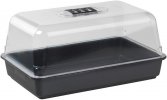David Waite
Western Thunderer
Hi Michael
The gap at the top and bottom of the window even the sides that is caused by the extractor air pipe could be blocked easily by using soft black rubber pipe insulation the type that is used for the refrigerant lines on Air conditioning systems it is made in various diameters and wall thickness, the thinner wall thickness will flatten more easily and it is cheap to buy usually comes in 2 meter lengths and easily cut with a sharp knife this could simply be squashed into the gaps and if the correct size is selected the friction hinges on your Velux windows should hold the window position with no problem my Velux windows are GGL4 type and their friction hinges could certainly do it, in any case if you use the push lock on the window there wouldn’t be a problem.
David.
The gap at the top and bottom of the window even the sides that is caused by the extractor air pipe could be blocked easily by using soft black rubber pipe insulation the type that is used for the refrigerant lines on Air conditioning systems it is made in various diameters and wall thickness, the thinner wall thickness will flatten more easily and it is cheap to buy usually comes in 2 meter lengths and easily cut with a sharp knife this could simply be squashed into the gaps and if the correct size is selected the friction hinges on your Velux windows should hold the window position with no problem my Velux windows are GGL4 type and their friction hinges could certainly do it, in any case if you use the push lock on the window there wouldn’t be a problem.
David.

